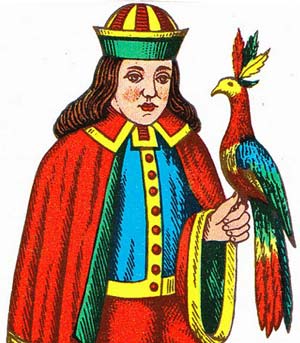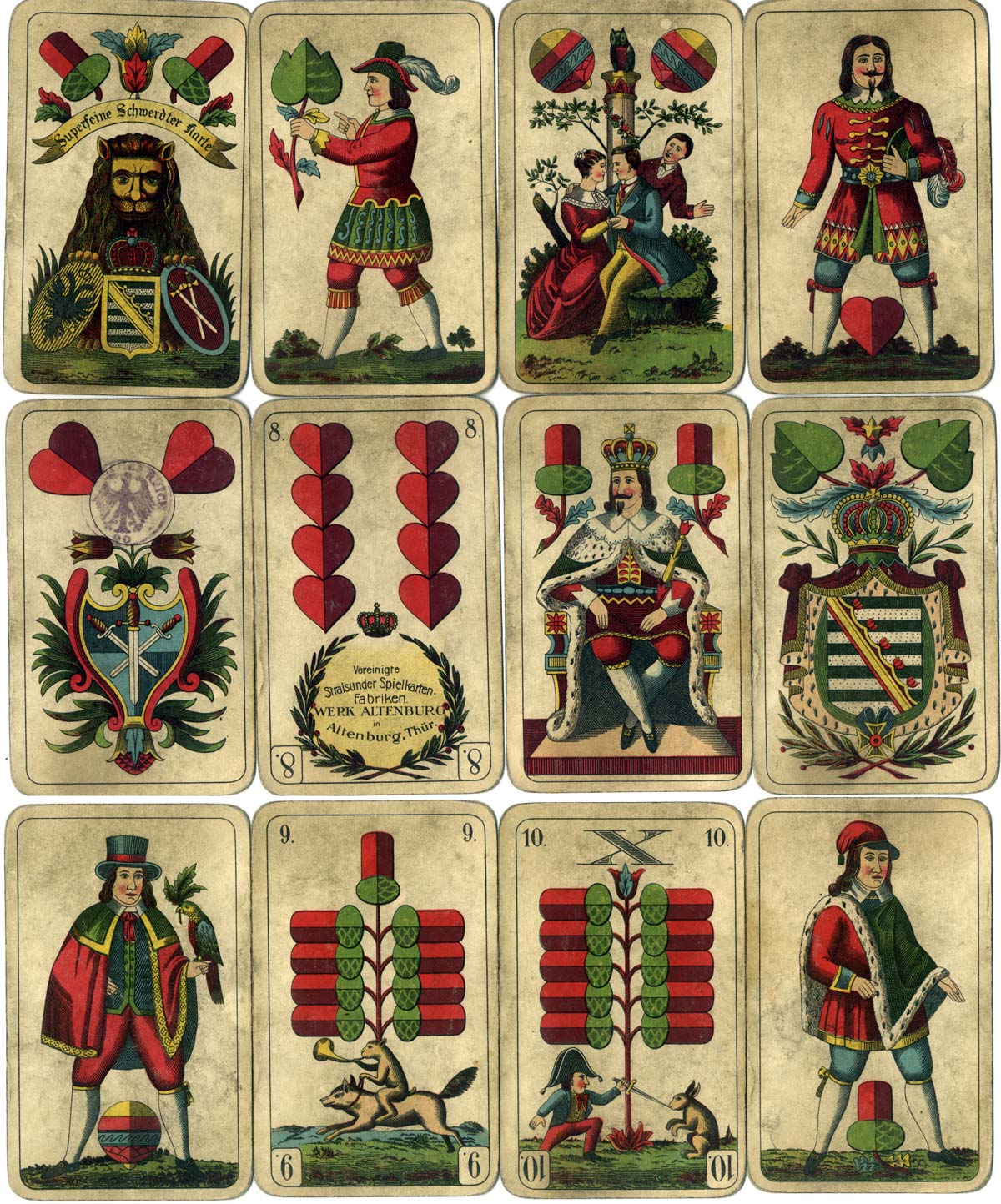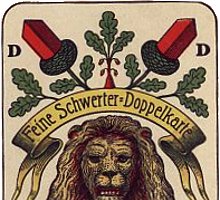German Saxon Pattern
The German Saxon Pattern or “Schwerdter Karte”.

The designs for the Saxon pattern probably originated in the 18th century, making it one of the older German-suited patterns. The Saxony coat-of-arms appears on the daus of acorns (under a lion's head) and on the daus of leaves. The pack is usually described on the daus of acorns as “Schwerdter Karte” or “Schwerter Karte” referring to the crossed swords on the coats-of-arms. The four kings are seated on thrones, each one having two suit symbols. The upper and lower knaves are all civilian figures, and the unter of bells has a bird perched on his wrist. In earlier versions six of the knaves wear hats with upturned brims, but in later versions the costumes have changed style and the unter of bells and the ober of leaves have top hats. The daus of bells shows a loving couple about to be discovered by a third person and the number cards have small decorative vignettes at the bottom.
The pack usually has 32 cards and was used principally for the game of Piquet in the early 19th century. It is known in single-figure and double-ended versions.
Earlier designs
These cards are a reproduction of an original from 1832 and feature the knaves wearing hats with upturned brims rather than top hats. Also the tunics are simpler in style than later versions and there is no ground beneath the courts' feet.

Above: cards from the Saxon pattern by VEB Altenburger Spielkartenfabrik, c.1986, reproducing an original design from 1832.
Later designs

Above: "Superfeine Schwerdter Karte" single-ended Saxon pattern, WW1 tax stamp on 2H, manufactured by Vereinigte Stralsunder Fabriken, c.1920. Some of the vignettes on the numeral cards are variations from the tradition and also the court figures are shown standing on grassy ground. Note the top hats which have replaced the softer headwear.
Double-ended Version
In the double-ended versions, although more convenient, many charming features of the designs are lost.

Above: cards from the double-ended Saxon pattern by Vereinigte Altenburger und Stralsunder Spielkarten-Fabriken A.G., 1932. 32 cards in box with advertising for Săchsische Autophil G.M.B.H. Crimmitschau.


By Simon Wintle
Member since February 01, 1996
Founder and editor of the World of Playing Cards since 1996. He is a former committee member of the IPCS and was graphics editor of The Playing-Card journal for many years. He has lived at various times in Chile, England and Wales and is currently living in Extremadura, Spain. Simon's first limited edition pack of playing cards was a replica of a seventeenth century traditional English pack, which he produced from woodblocks and stencils.
Related Articles

Politiker-Skat by Bubec
Caricatures of world leaders, including many German politicians, by the artist Bubec.

Le Poker Politique
French politicians and various world leaders caricatured by the German artist Bubec.

Modern Jass (Fredy Sigg)
Caricatural updating of traditional Swiss Jass cards by the artist Fredy Sigg.

Rouen Pattern - Portrait Rouennais
An attractive XV century French-suited design from Rouen became the standard English & Anglo-America...

Unimog UX 100
Cartoons promoting the Unimog UX 100, a small truck produced by Mercedes-Benz.

Juristenskat
Caricatures of lawyers and judges by Philipp Heinisch for HEEL Verlag.

Battles in Mexico, 1847
Uncut proof sheet with Mexican Battle scenes on the aces and portraits of American generals on the c...

Double-ended German-suited pack by Josef Glanz, Vienna.
From the British Museum collection.

Ganjifa - Playing Cards from India
Indian playing cards, known as Ganjifa, feature intricate designs with twelve suits and are traditio...

Medizin Skat
Promotional pack for a hospital group in the Saarland, with non-standard suits and courts designed b...

The Henry Hart Puzzle
Explore the intricate history and unique design variations of Henry Hart's playing cards, tracing th...

Opernkarte I
Humorous designs by Peter Becker on the theme of the Opera.

Sevilla 1647 reproduction
Facsimile of Spanish-suited pack produced in Sevilla, Spain, 1647.

Why our playing-cards look the way they do
Analysis of early playing card designs: origins, suit differences, standardization, technological ad...

Introduction to Collecting Themes
Playing cards can be broadly categorised into standard and non-standard designs, with collectors app...

Le Monde Primitif Tarot
Facsimile edition produced by Morena Poltronieri & Ernesto Fazioli of Museo Internazionale dei Taroc...
Trending Articles
Popular articles from the past 28 days


